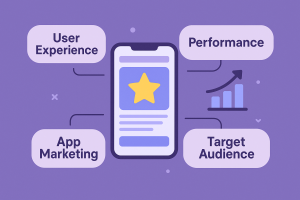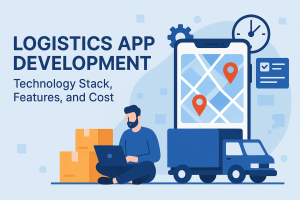As we know businesses of all sizes are rapidly adopting mobile technology to reach their target audiences, streamline operations, and drive growth. However, developing a high-quality mobile app can be expensive and complex. This is where offshore mobile app development comes into play. By leveraging global talent and competitive pricing, companies can achieve robust, scalable mobile solutions without burning a hole in their pockets.
In this comprehensive guide, we’ll explore everything you need to know about cost-effective offshore mobile app development, from its fundamentals and benefits to budgeting, managing remote teams, and avoiding common pitfalls. Whether you’re a startup with a shoestring budget or an established enterprise looking to optimize costs, this guide is designed to empower you with the insights and strategies needed to succeed.
Understanding Offshore Mobile App Development
Offshore mobile app development refers to the process of outsourcing the design, development, and maintenance of mobile applications to teams or companies located in different countries. The primary objective is to leverage the expertise and cost advantages offered by these locations, which often come with lower labor costs and a deep pool of technical talent.
What Does Offshore Mobile App Development Involve?
Developing an app offshore encompasses a variety of processes, including:
- Project Planning and Requirement Analysis: Defining the app’s scope, target audience, and technical requirements.
- Design and Prototyping: Crafting user interfaces and creating interactive prototypes to ensure the app’s usability.
- Development and Testing: Writing code, integrating features, and rigorous quality assurance to ensure a bug-free product.
- Deployment and Maintenance: Launching the app on app stores and continuously updating it based on user feedback and evolving market trends.
By choosing offshore development, businesses can significantly reduce costs without sacrificing quality. In fact, many organizations have found that Offshore Mobile App Development not only offers competitive pricing but also access to a diverse range of skills and expertise that may not be available locally.
The Rising Trend of Offshore Mobile App Development

Over the last decade, the mobile app industry has grown exponentially. With billions of smartphone users worldwide, mobile applications have become essential for engaging customers, streamlining operations, and building brand loyalty. However, as the demand for sophisticated apps increases, so do the challenges related to development cost and technical expertise.
Why Businesses Are Turning Offshore
Several factors contribute to the rising popularity of offshore mobile app development:
- Cost Savings: Labor costs in many offshore locations are significantly lower compared to those in North America or Western Europe. This cost differential allows companies to allocate more resources toward app innovation.
- Access to Global Talent: Offshore markets are teeming with skilled developers who are well-versed in the latest technologies and agile methodologies.
- Scalability: Offshore teams offer flexibility in scaling operations up or down based on project requirements, ensuring that companies only pay for what they need.
- Faster Time-to-Market: With 24/7 development cycles and time zone advantages, offshore teams can accelerate project timelines.
This global trend is not merely a passing fad. It represents a strategic shift in how businesses approach technology development, balancing budget constraints with the need for high-quality, innovative solutions.
Benefits of Offshore Mobile App Development
Outsourcing mobile app development offshore offers a myriad of benefits beyond mere cost reduction. Here, we break down the key advantages:
1. Significant Cost Savings
The most compelling reason to opt for offshore development is the potential for substantial cost savings. By outsourcing to countries with lower labor costs, businesses can achieve significant reductions in development expenses without compromising on quality. These savings can be redirected toward marketing, user acquisition, or further R&D efforts.
2. Access to a Broader Talent Pool
When you look beyond local boundaries, you open the door to a diverse array of skills and expertise. Offshore teams often have deep domain expertise in various technologies—from native iOS and Android development to cross-platform frameworks like React Native and Flutter. This diversity enables companies to choose the best professionals for specific project requirements.
3. Enhanced Flexibility and Scalability
Offshore development provides the flexibility to scale teams based on project needs. Whether you require a small team for a minimal viable product (MVP) or a larger group for a complex enterprise solution, offshore providers can adjust their resources accordingly. This adaptability ensures that your project remains agile and responsive to market demands.
4. Accelerated Time-to-Market
With a global workforce operating in different time zones, your project can benefit from a near-continuous development cycle. This “follow-the-sun” model means work continues around the clock, significantly reducing development time and enabling faster product launches.
5. Innovation and Diverse Perspectives
Working with offshore teams brings together diverse perspectives and innovative approaches to problem-solving. These teams often have experience working on a variety of projects and can provide creative solutions that might not emerge within a homogeneous local team.
6. Focus on Core Business Activities
By outsourcing the technical development to experts, companies can focus more on their core business strategies. This allows management to concentrate on high-level decision-making, customer engagement, and strategic planning rather than being bogged down by technical challenges.
Key Considerations Before You Go Offshore
While offshore mobile app development offers many advantages, it’s important to approach the process strategically. Here are several key considerations to ensure a smooth and successful outsourcing experience.
Defining Your Project Requirements
Before initiating any offshore project, clarity is essential. Define your project’s scope, features, target audience, and desired outcomes. A well-documented requirement specification can significantly reduce misunderstandings and ensure that both parties have a shared vision of the final product.
Legal and Regulatory Compliance
Offshore development may involve navigating different legal and regulatory landscapes. It’s crucial to establish clear contracts that address intellectual property rights, confidentiality, and data security. Understanding local laws and ensuring compliance can protect your business interests and avoid potential legal complications.
Communication Strategies
Effective communication is the backbone of successful offshore collaboration. Establish clear channels for regular updates, progress tracking, and feedback. Using project management tools and scheduling periodic video conferences can help bridge any geographical or cultural gaps.
Time Zone Differences
While time zone differences can offer the advantage of round-the-clock development, they may also pose challenges. Plan for overlapping work hours to facilitate real-time discussions and ensure timely decision-making. A structured communication plan can mitigate potential delays and misunderstandings.
Cultural Compatibility
Cultural differences can influence work styles and communication. Investing time in understanding the cultural nuances of your offshore partner’s region can foster better collaboration and mutual respect. Consider arranging initial meetings or team-building activities to build rapport and trust.
Budgeting and Cost Analysis

Budgeting is one of the most critical aspects of any offshore mobile app development project. By understanding the various cost components and planning accordingly, you can ensure that your project stays within budget while achieving your desired outcomes.
Cost Components of Offshore Mobile App Development
- Development Costs: This includes the salaries or fees of developers, designers, and quality assurance professionals. Offshore teams typically offer competitive rates compared to local markets.
- Project Management: Effective management is key to keeping the project on track. Budget for project managers or account managers who can coordinate activities and serve as the liaison between your team and the offshore partner.
- Infrastructure and Tools: Consider the cost of software licenses, collaboration tools, and other resources needed to support the development process.
- Quality Assurance: Rigorous testing is essential for delivering a high-quality product. Budget for dedicated testing phases, bug fixes, and iterative improvements.
- Maintenance and Updates: Post-launch support, regular updates, and feature enhancements are ongoing costs that should be factored into your overall budget.
Creating a Realistic Budget
When creating your budget, it’s important to factor in both direct and indirect costs. Direct costs include the fees paid to the offshore team, while indirect costs may involve management oversight, communication expenses, and any potential delays. A detailed cost analysis can help you identify potential savings and allocate resources more effectively.
Hidden Costs and Risk Mitigation
Offshore development may sometimes come with hidden costs such as unforeseen delays, additional rounds of revisions, or increased management overhead. To mitigate these risks, consider the following strategies:
- Detailed Contracts: Clearly outline deliverables, timelines, and quality standards in your contract.
- Contingency Planning: Allocate a portion of your budget as a contingency fund to cover unexpected expenses.
- Regular Reviews: Schedule periodic project reviews to ensure that milestones are met and any issues are addressed promptly.
Tools for Budgeting and Cost Management
Utilize project management and budgeting tools to keep track of expenditures and monitor progress. Tools like Trello, Asana, or even dedicated financial software can help you maintain transparency and control over your budget throughout the project lifecycle.
Choosing the Right Offshore Partner

Finding the right offshore partner is arguably one of the most critical steps in ensuring the success of your mobile app development project. The right partner not only brings technical expertise but also understands your business goals and can work seamlessly with your in-house team.
What to Look for in an Offshore Partner
- Technical Expertise: Look for teams with a proven track record in mobile app development. Assess their portfolio, client testimonials, and case studies to gauge their competence.
- Communication Skills: Effective communication is key. Ensure that the team is proficient in your language and has a robust system in place for regular updates.
- Cultural Fit: Evaluate whether the team’s work culture aligns with your company’s values and operating style.
- Transparent Pricing: Choose a partner that offers clear and transparent pricing structures without hidden fees.
- Proven Processes: A well-documented development process, including agile methodologies, can indicate a partner’s commitment to quality and timely delivery.
Researching and Shortlisting Potential Partners
Start by researching online and seeking recommendations from industry peers. Look for reviews, testimonials, and success stories. Resources like the guide to app developers near me benefits pricing hiring and trends provide valuable insights into what to expect when hiring offshore teams and how to assess their capabilities.
Evaluating Technical Capabilities
Arrange for preliminary discussions or technical interviews to assess the candidate’s proficiency. Request sample projects or code repositories to evaluate their work quality and coding standards. Additionally, consider starting with a small pilot project before committing to a long-term contract.
Contractual Considerations
Ensure that all agreements are clearly documented in a contract. The contract should cover aspects such as intellectual property rights, payment terms, timelines, and dispute resolution procedures. A well-structured contract is the foundation of a successful offshore partnership.
Onboarding and Integration
Once you’ve selected an offshore partner, invest time in onboarding them into your project. Provide detailed project briefs, set up communication channels, and integrate them with your in-house team. This onboarding phase is crucial for aligning expectations and ensuring a smooth workflow.
For further insights into the nuances of team selection, consider reading about finding the best app developers near you, which highlights key strategies for evaluating technical talent.
Managing Offshore Teams Effectively
The success of an offshore project largely depends on how well you manage the remote team. Effective management can bridge the gap between geographical distances and ensure that the project proceeds smoothly.
Establishing Clear Communication Channels
- Regular Meetings: Schedule daily or weekly meetings to discuss progress, address challenges, and realign priorities. Video conferencing tools like Zoom or Microsoft Teams can facilitate face-to-face interactions.
- Project Management Tools: Use platforms like Jira, Trello, or Asana to track tasks, assign responsibilities, and monitor progress.
- Real-Time Communication: Encourage the use of instant messaging apps such as Slack for quick updates and collaborative problem-solving.
Setting Clear Goals and Expectations
Define measurable objectives and key performance indicators (KPIs) from the outset. Clear goals help the offshore team understand your expectations and provide a benchmark for evaluating progress. Regular performance reviews and feedback sessions can help maintain alignment and motivate the team.
Cultural Sensitivity and Team Building
Understanding and respecting cultural differences can significantly enhance collaboration. Consider organizing virtual team-building activities or cross-cultural training sessions to foster better understanding and camaraderie.
Time Management and Overlapping Work Hours
Effective time management is crucial when dealing with different time zones. Identify overlapping hours during which both your in-house team and the offshore team are available. This window can be used for synchronous meetings, brainstorming sessions, and urgent discussions.
Monitoring Progress and Providing Feedback
Utilize milestone reviews and sprint retrospectives to track progress and address any issues promptly. Constructive feedback helps improve performance and keeps the project on track.
Essential Strategies for a Successful Offshore Project
Achieving success in offshore mobile app development requires a strategic approach that encompasses technical planning, project management, and risk mitigation. Here are some strategies to consider:
Detailed Project Documentation
Comprehensive documentation is essential for any software development project. Ensure that all aspects of the project—from requirements and design specifications to testing protocols—are thoroughly documented. This documentation serves as a reference for both your team and the offshore partner.
Agile Development Methodology
Adopting agile methodologies can significantly enhance project flexibility and responsiveness. Agile practices, such as iterative development, regular sprints, and continuous feedback loops, allow for rapid adjustments based on user feedback and evolving requirements.
Emphasizing Quality Assurance
Invest in robust quality assurance processes throughout the development lifecycle. Automated testing, code reviews, and beta testing can help identify issues early and ensure that the final product meets high-quality standards.
Risk Management and Contingency Planning
Identify potential risks early and develop contingency plans to address them. This proactive approach can minimize delays and reduce unforeseen expenses.
Embracing Innovation
Encourage creative problem-solving and be open to exploring new technologies and frameworks. An innovative mindset not only enhances the app’s functionality but also gives you a competitive edge in the market.
Leveraging Collaborative Tools
Utilize collaboration tools that facilitate seamless communication and document sharing between your in-house and offshore teams. Cloud-based platforms and version control systems can streamline the development process and ensure that everyone is on the same page.
Continuous Learning and Improvement
Foster an environment of continuous learning. Regularly review project outcomes, learn from any setbacks, and implement improvements in subsequent development cycles. This iterative approach ensures that your team evolves and adapts to new challenges.
For beginners looking to get started in the world of app development, it might be helpful to refer to mobile app development a guide for beginners, which provides foundational insights into the development process.
Common Pitfalls and How to Avoid Them

While offshore mobile app development offers significant benefits, it also comes with its unique set of challenges. Being aware of these common pitfalls and knowing how to avoid them can save you time, money, and frustration.
1. Poor Communication
One of the most common issues in offshore development is ineffective communication. This can lead to misunderstandings, missed deadlines, and a product that doesn’t meet your expectations. To avoid this, establish clear communication channels, schedule regular meetings, and use collaboration tools to ensure everyone is aligned.
2. Inadequate Documentation
Lack of thorough documentation can result in confusion and misinterpretation of requirements. Always invest time in creating detailed documentation for every stage of the project, from planning to post-launch maintenance.
3. Cultural and Time Zone Differences
Cultural differences and time zone disparities can hinder the smooth progress of your project. Address these challenges by setting overlapping work hours, promoting cultural sensitivity, and being flexible with scheduling.
4. Underestimating the Project Scope
A common mistake is underestimating the complexity and scope of the project, which can lead to budget overruns and delays. Conduct a comprehensive analysis during the planning phase and include a contingency budget for unforeseen challenges.
5. Neglecting Quality Assurance
Rushing through the development process without adequate testing can compromise the quality of your app. Prioritize quality assurance at every stage, from code reviews to extensive beta testing.
For a more detailed discussion on avoiding pitfalls, take a look at the article on 5 common mistakes to avoid in mobile app development. This resource offers practical tips to steer clear of common errors and ensure a smoother development journey.
Success Stories and Case Studies

Learning from the experiences of other companies can provide valuable insights into the benefits and challenges of offshore mobile app development. Here, we explore several success stories and case studies that illustrate the power of offshore collaboration.
Case Study 1: A Startup’s Journey to a Market-Leading App
A small startup based in North America decided to leverage offshore talent to develop a groundbreaking mobile application. Facing budget constraints and tight deadlines, the startup partnered with an offshore development team known for its expertise in agile methodologies. The results were impressive—a robust app launched ahead of schedule, significant cost savings, and the flexibility to quickly iterate based on user feedback. This success story underscores how effective planning and clear communication can drive innovation even with limited resources.
Case Study 2: Scaling an Enterprise Solution
An established enterprise in the finance sector needed to upgrade its mobile banking app to meet modern security standards and enhance user experience. By collaborating with an offshore team, the enterprise was able to tap into specialized expertise while maintaining strict compliance with industry regulations. The collaboration led to a successful relaunch of the app with enhanced features, improved security, and a more intuitive user interface—all achieved at a fraction of the cost of local development.
Lessons Learned
- Clear Objectives: Define your goals and success metrics early in the project.
- Flexibility: Be open to iterative improvements based on ongoing feedback.
- Trust and Collaboration: Build a strong working relationship with your offshore partner through transparency and regular updates.
Future Trends in Offshore Mobile App Development

The landscape of mobile app development is continuously evolving. Here are some emerging trends that are likely to shape the future of offshore development:
1. Adoption of Emerging Technologies
With rapid advancements in technology, offshore teams are increasingly incorporating emerging tools and frameworks into their workflows. Technologies such as artificial intelligence (AI), machine learning (ML), augmented reality (AR), and blockchain are finding their way into mobile app development, offering enhanced functionalities and improved user experiences.
2. Increasing Emphasis on Cybersecurity
As mobile apps handle sensitive user data, cybersecurity remains a top priority. Offshore development teams are investing more in secure coding practices, rigorous testing, and compliance with global data protection standards to ensure that apps are robust against cyber threats.
3. The Rise of Low-Code and No-Code Platforms
Low-code and no-code platforms are transforming the development landscape by enabling rapid prototyping and faster time-to-market. These platforms are especially beneficial for businesses with limited technical resources, making mobile app development more accessible and cost-effective.
4. Remote Work as the New Normal
The global shift toward remote work is likely to persist, further normalizing the concept of offshore development. With improved communication tools and project management software, geographical barriers are becoming less of an issue, making collaboration even smoother.
5. Data-Driven Decision Making
Offshore teams are increasingly leveraging analytics and data-driven insights to refine app features and user experience. Continuous monitoring of user behavior and iterative enhancements based on data can drive significant improvements in app performance.
Conclusion
Offshore mobile app development presents a compelling solution for businesses looking to combine quality with cost efficiency. By tapping into a global talent pool, companies can develop innovative, high-quality mobile applications while managing budgets effectively. From meticulous planning and clear communication to leveraging emerging technologies and avoiding common pitfalls, the strategies outlined in this guide offer a roadmap to success in the offshore arena.
Whether you are a startup striving for a market breakthrough or an established enterprise seeking to optimize your technology investments, understanding the dynamics of offshore development can be a game changer. As the industry continues to evolve, embracing these practices will not only help you stay ahead of the curve but also ensure that you deliver products that meet—and exceed—user expectations.
In the competitive world of mobile app development, being agile, innovative, and cost-conscious can make all the difference. By taking the plunge into offshore development, you open up a world of opportunities to achieve your business goals while keeping your project budget-friendly and your app at the cutting edge of technology.
Key Takeaways
- Cost Savings: Offshore mobile app development offers significant savings compared to local development without compromising on quality.
- Global Talent: Access a diverse talent pool that brings innovative ideas and expertise to your project.
- Flexibility: Enjoy the scalability and adaptability of offshore teams, making it easier to manage project fluctuations.
- Effective Management: Success hinges on clear communication, robust project management, and cultural understanding.
- Future-Ready: Embrace emerging technologies and remote work trends to stay ahead in the competitive app market.
By keeping these points in mind, you can build a strategy that not only meets your current needs but also positions your business for long-term success.
Final Thoughts
The journey of developing a mobile app is both challenging and rewarding. Offshore mobile app development offers a pathway to harness global expertise while keeping your project on budget. As you plan your project, be sure to invest in thorough research, clear communication, and continuous improvement. This proactive approach will help you avoid common pitfalls and set the stage for a successful launch.







